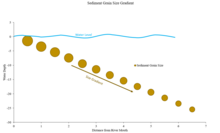31:
39:
342:
113:
Tangential sorting is the result of sediment being deposited in same direction as flow. Normal tangential sorting results in a gradient of sediment sizes deposited from largest to finest as they travel downstream. When sediments are deposited from smallest to largest as they travel downstream, this
156:
In reference to windblown sediment, a wide range of conditions such as distance and height of transport and varying wind patterns at the sediment source can affect grain size, rate of transport and distribution of sediment. Windblown sediment travels one of three ways--rolling,
167:
that is reworked by fluvial processes tends to have more poorly sorted sediment as compared to sediment sorted by only
Aeolian processes because loess particles become mixed with preexisting sediment of varying grain sizes within bodies of water.
93:
The terms describing sorting in sediments – very poorly sorted, poorly sorted, moderately sorted, well sorted, very well sorted – have technical definitions and semi-quantitatively describe the amount of variance seen in particle
383:
65:. The degree of sorting is determined by the range of grain sizes in a sediment deposit and is the result of various transport processes (
144:. As a result, studying the degree of sorting in deposits of sediment can give insight into the energy, rate, and/or duration of
122:
376:
117:
Rocks derived from well sorted sediments are commonly both porous and permeable, while poorly sorted rocks have low
402:
85:
size, which refers to the individual size of a crystal in a solid. Crystallite is the building block of a grain.
141:
407:
369:
145:
298:
252:
197:
182:
158:
137:
110:
use graphical charts to accurately describe the sorting of a sediment using one of these terms.
318:
272:
207:
202:
74:
353:
310:
299:"Grain size of fine-grained windblown sediment: A powerful proxy for process identification"
264:
62:
34:
Sediment consisting of well sorted grains (left) compared with poorly sorted grains (right).
136:
Sediment sorting is influenced by: grain sizes of sediment, processes involved in grain
177:
58:
268:
396:
107:
314:
231:
192:
38:
30:
17:
82:
70:
42:
Distribution of grain sizes based on water depth and distance from river mouth.
212:
50:
322:
276:
148:, as well as the transport process responsible for laying down the sediment.
349:
341:
106:
indicates that the sediment sizes are similar (low variance). In the field,
187:
118:
99:
54:
78:
164:
66:
37:
357:
140:, deposition, and post-deposition processes such as
98:indicates that the sediment sizes are mixed (large
253:"Sorting in grain flows at the lee side of dunes"
377:
8:
238:, John Wiley & Sons, Chichester, 153 p.
384:
370:
81:, etc.). This should not be confused with
29:
224:
27:Distribution of grain size of sediments
7:
338:
336:
292:
290:
288:
286:
246:
244:
114:is referred to as reverse sorting.
356:. You can help Knowledge (XXG) by
125:, particularly when fine grained.
25:
340:
297:Vandenberghe, Jef (2013-06-01).
315:10.1016/j.earscirev.2013.03.001
251:Kleinhans, M. G. (2004-03-01).
236:Sedimentary rocks in the field
49:describes the distribution of
1:
269:10.1016/S0012-8252(03)00081-3
132:Processes involved in sorting
424:
335:
161:or suspension in the air.
348:This article related to
43:
35:
303:Earth-Science Reviews
257:Earth-Science Reviews
41:
33:
96:Very poorly sorted
89:Sorting parameters
44:
36:
403:Sedimentary rocks
365:
364:
208:Aeolian transport
203:Fluvial processes
152:Aeolian processes
63:sedimentary rocks
18:Sorting (geology)
16:(Redirected from
415:
386:
379:
372:
344:
337:
327:
326:
294:
281:
280:
248:
239:
229:
108:sedimentologists
21:
423:
422:
418:
417:
416:
414:
413:
412:
408:Petrology stubs
393:
392:
391:
390:
333:
331:
330:
296:
295:
284:
250:
249:
242:
230:
226:
221:
174:
154:
134:
127:
91:
61:deposits or in
28:
23:
22:
15:
12:
11:
5:
421:
419:
411:
410:
405:
395:
394:
389:
388:
381:
374:
366:
363:
362:
345:
329:
328:
282:
240:
223:
222:
220:
217:
216:
215:
210:
205:
200:
195:
190:
185:
180:
178:Graded bedding
173:
170:
153:
150:
133:
130:
90:
87:
59:unconsolidated
26:
24:
14:
13:
10:
9:
6:
4:
3:
2:
420:
409:
406:
404:
401:
400:
398:
387:
382:
380:
375:
373:
368:
367:
361:
359:
355:
351:
346:
343:
339:
334:
324:
320:
316:
312:
308:
304:
300:
293:
291:
289:
287:
283:
278:
274:
270:
266:
263:(1): 75–102.
262:
258:
254:
247:
245:
241:
237:
233:
228:
225:
218:
214:
211:
209:
206:
204:
201:
199:
196:
194:
191:
189:
186:
184:
181:
179:
176:
175:
171:
169:
166:
162:
160:
151:
149:
147:
143:
139:
131:
129:
128:
124:
120:
115:
111:
109:
105:
101:
97:
88:
86:
84:
80:
76:
72:
68:
64:
60:
56:
52:
48:
40:
32:
19:
358:expanding it
347:
332:
306:
302:
260:
256:
235:
232:Tucker, M.E.
227:
193:Soil texture
163:
155:
135:
126:
123:permeability
116:
112:
103:
95:
92:
57:, either in
46:
45:
104:well sorted
102:); whereas
83:crystallite
71:debris flow
397:Categories
219:References
213:Grain Size
198:Deposition
146:deposition
51:grain size
350:petrology
323:0012-8252
309:: 18–30.
277:0012-8252
159:saltation
142:winnowing
138:transport
55:sediments
234:, 1996,
188:Porosity
183:Rounding
172:See also
121:and low
119:porosity
100:variance
79:glaciers
47:Sorting
321:
275:
94:sizes.
67:rivers
352:is a
165:Loess
354:stub
319:ISSN
273:ISSN
75:wind
311:doi
307:121
265:doi
53:of
399::
317:.
305:.
301:.
285:^
271:.
261:65
259:.
255:.
243:^
77:,
73:,
69:,
385:e
378:t
371:v
360:.
325:.
313::
279:.
267::
20:)
Text is available under the Creative Commons Attribution-ShareAlike License. Additional terms may apply.

